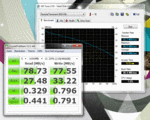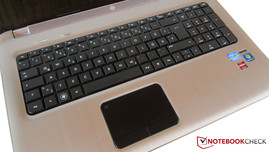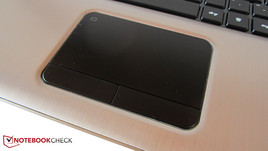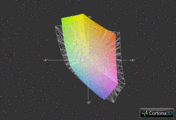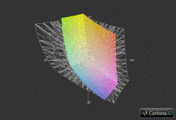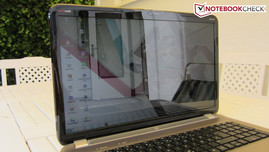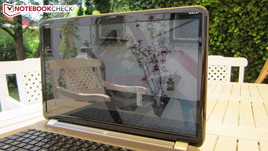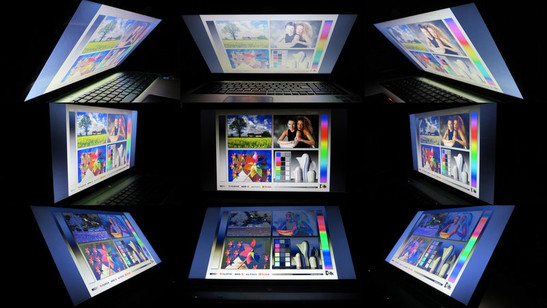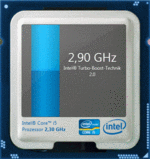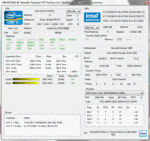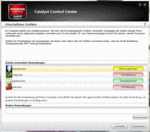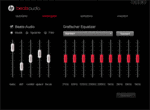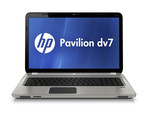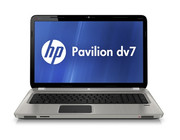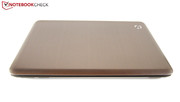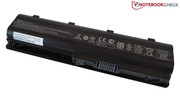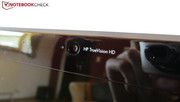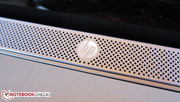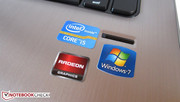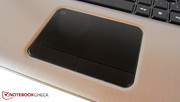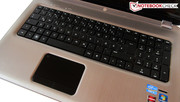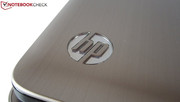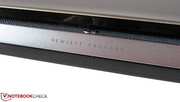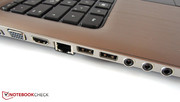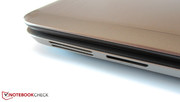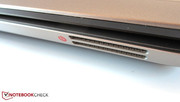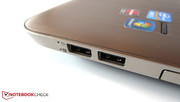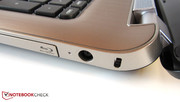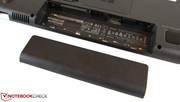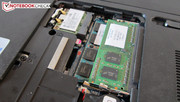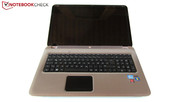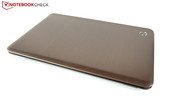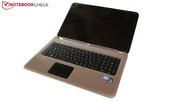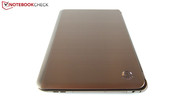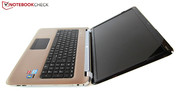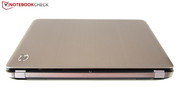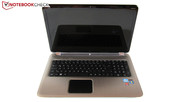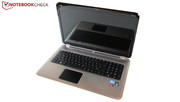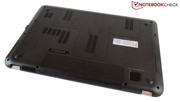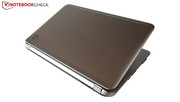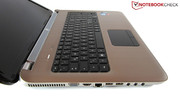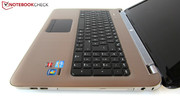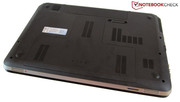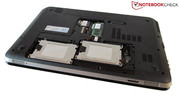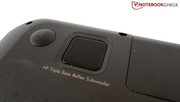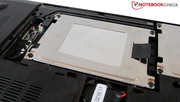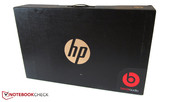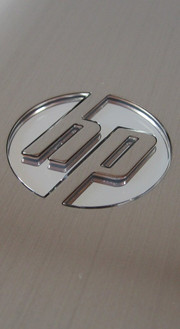Review HP Pavilion dv7-6101eg Notebook
There are masses of 17-inch entertainment notebooks to be found in the great expanse of the internet. But if you sift through them looking for the best possible performance for a reasonable price, you will quickly find yourself looking at the HP dv7-6100 series. For less than €1,000 you can get a graphics card from the top of the mid range. The models that come with the Radeon HD 6770M are definitely preferable in terms of performance to the ones with the HD 6755G2 or HD 6490M.
The processor is either a dual-core (Core i5-2410M) or a quad-core (Core i7-2630QM or A6-3410MX). The DDR3 RAM ranges from 4 GB up to a maximum of 8 GB, while the hard drive capacity ranges from 500 to 2000 GB. Film fans should definitely choose a version with a Blu-Ray drive, or they will have to put up with a conventional DVD burner. The buyer has no choice when it comes to the operating system; Windows 7 Home Premium 64 Bit is pre-installed, which is standard for notebooks.
Case
We think the dv7-6101eg has a great look. The steel-grey metal surfaces are scratch resistant and give the laptop a high-quality appearance. The build quality of our review model was convincing, apart from the hard bottom edge of the keyboard, and the screen edging which sticks out slightly. The laptop’s shape and overall design are fresh and yet classy at the same time; the notebook looks smart from every angle.
The very robust base unit is another point in the notebook’s favour. Only under strong pressure do the keyboard (particularly the number block) and the area around the HP logo start to flex a little. However, the lid can be flexed noticeably - a typical notebook shortcoming. The hinges come in for a lot of criticism; the display can wobble heavily when the base unit is shaken, and you need two hands to open the lid.
Overall HP have got almost everything right, with the case feeling like a cross between the Dell XPS 17 and the HP Envy 17. The size and weight are acceptable for a notebook; at 3.1 kg it can be readily transported.
Connectivity
Ports
The range of ports turns out to be relatively small. In contrast to many other notebooks, this one does without an ExpressCard slot as well as a Firewire port and an eSATA port. With the exception of the two state-of-the-art USB 3.0 ports, there is nothing beyond the standard here.
In our opinion, HP should rethink the layout of the ports. With all of them positioned on the side edges, they are within easy reach, but when lots of cables are attached it restricts the space available to the right and left of the machine.
Communication
You can connected to the internet using a wired RJ-45 Gigabit LAN connection, or wirelessly over b/g/n WLAN. Bluetooth is not supported by the Broadcom module used here.
Other Features
HP regains some of its lost ground in this area with an integrated fingerprint scanner and TrueVision HD webcam.
Software
HP has filled the dv7-6101eg with a large amount of software, following the usual approach of the major notebook manufacturers. Windows 7 reacts fairly sluggishly, especially just after start-up, with a variety of program icons populating the notification area of the taskbar. Tip: although the pre-installed CyberLink PowerDVD 10 OEM program is supposed to be able to handle Blu-Rays, our test film (Casino Royale) could not be played.
Accessories
Don’t expect much in the way of accessories from the dv7-6101eg. Other than the battery (six-cell) and the mains adaptor (120 Watts), all that comes with the notebook is a quick start guide - no driver and tools DVD, and no recovery DVD.
Warranty
The warranty is for 24 months, as is usual for a notebook. HP calls it a Pickup and Return service.
Input devices
Keyboard
Despite some good efforts, the keyboard did not succeed in winning us over entirely. The free-standing, 15 x 15 mm keys respond well (though their tactile feedback and point of impact could be a little clearer), but the noise they make is pretty loud and rattly. Meanwhile there is not much to complain about in terms of the layout; most users will easily find their way around.
Useful special functions (such as brightness and volume controls, etc) are activated without having to press the Fn key. This is different to what we are used to seeing on most of the competition. On the other hand, the presence of a separate number block should not surprise anyone. HP has decided against keyboard backlighting - a shame for users who like to work or play games at night.
Touchpad
The touchpad has white backlighting and earns itself a somewhat better report from us. We particularly like its generous dimensions; the 95 x 55 mm surface should allow you to handle large portions of the screen without difficulty. Its support for multi-touch is also a positive feature. In the touchpad driver, a range of gestures are waiting to be individually configured. In terms of accuracy the touchpad ranks somewhere in the middle, with most inputs being correctly interpreted.
As HP has positioned the touchpad slightly to the left, you do not necessarily have to deactivate it when gaming. However, we found the rubberized surface of the pad to be less than optimal. It is not especially easy for the finger to slide smoothly across it; there is unnecessary friction.
Display
HP has not tried anything unusual with the display. The 17.3-inch glossy panel offers HD+ resolution, LED backlighting and an aspect ratio of 16:9. The resolution is well chosen with regard to the graphics performance; the Radeon HD 6770M will be able to cope with a 1600 x 900 resolution for many games even on the high detail setting.
| |||||||||||||||||||||||||
Brightness Distribution: 95 %
Center on Battery: 204 cd/m²
Contrast: 162:1 (Black: 1.26 cd/m²)57.4% AdobeRGB 1998 (Argyll 2.2.0 3D)
78.5% sRGB (Argyll 2.2.0 3D)
56.7% Display P3 (Argyll 2.2.0 3D)
Unfortunately the display is thoroughly disappointing in practice. The Samsung 173KT01-K01 (SEC3354) panel’s picture quality is no more than mediocre. Its average brightness of 202.9 cd/m² may be enough for indoor use, but when you take it outside you will wish it were brighter. The black value of 1.26 cd/m² is also less than you would hope, with the result that dark sections of films and games have a noticeably greyish tinge.
The contrast ratio is correspondingly low, at 162:1; a figure which higher-quality panels (the Asus G74SX for example) would smirk about. And the picture makes a rather dismal impression even to the naked eye, with the colours seeming washed out. However, in general the multimedia competition does not do much better - high-class alternatives like the Schenker XMG A501 are hard to find in the sub-€1,000 price range
A further problem is the glossy screen finish. If the laptop is badly positioned then distracting reflections can appear, even within your own four walls. Outside, the dv7-6101eg is completely out of its comfort zone, and in strong sunlight it is sometimes difficult to make out anything at all on the screen. In a nutshell: the 17-inch machine is best suited to an indoorsy kind of person.
Finally, a few words on the notebook’s viewing angles. While the display can tolerate small horizontal deviations reasonably well, any vertical deviation very quickly leads to changes in the picture. The user will frequently have to adjust the display, and it would be difficult to enjoy a proper film night with several friends round the computer.
Performance
Processor: Intel Core i5-2410M
At work inside the dv7-6101eg is a dual-core processor, one of Intel’s powerful Sandy Bridge generation. The Core i5-2410M is an incredibly popular mid-range model which has more than 624 transistors as well as a 3 MB L3 cache. Like all the Sandy Bridge CPUs, it is made using the latest 32 nm process. Thanks to Hyperthreading technology the processor can handle up to four threads simultaneously; this is achieved by simulating two virtual cores.
But for gamers, the processor’s Turbo Mode is more important. Depending on the temperature and system load, the speed of each core is made to vary between the standard 2.30 GHz and a maximum of 2.90 GHz. We briefly tested Turbo Mode using the Cinebench R10 tool. While the speed in the single-core rendering varied between 2.80 and 2.90 GHz, in the multi-core rendering the processor settled at 2.7 GHz. The thermal design power of 35 Watts is not exactly low, but on the other hand the Core i5-2410M does also contain a HD Graphics 3000 graphics chip.
CPU Performance
In the CPU benchmarks we pitted the Core i5-2410M against the quad-core Core i7-2630QM (HP dv6-6008eg) which is built into some of the other dv7 models. In the single-core rendering part of the Cinebench R10 64 Bit test, the difference was minimal; the processors performed at a similar level, at 4551 to 4525 points. In the multi-core rendering, however, the Core i7-2630QM is able to exploit its greater number of cores, scoring 16,755 points compared to the i5’s 9660 points, an advantage of 73%.
The Core i7-2630QM takes an even clearer lead in the CPU benchmark of the Cinebench R11.5 64 Bit test; with 4.83 versus 2.61 points, the quad-core processor is about 85% ahead - respect. So if you do work a lot with applications that can profit from having more than two (actual) cores, it would be better to look at a dv7 model that comes with the Core i7-2630QM. But the average user will probably be happy with the Core i5-2410M.
Graphics Card: AMD Radeon HD 6770M
HP have gone for a graphics card from the higher end of the mid-range level. AMD’s DirectX 11 capable Radeon HD 6770M has hardly been used by other notebook manufacturers so far. Without good cause, in our opinion, as the graphics card offers an excellent price-to-performance ratio, as well as a good balance between performance and energy consumption.
Compared to the current top model, the Radeon HD 6970M, AMD has exactly halved the number of stream processors from 960 to 480. However, the core and shader speeds are a little higher than the Radeon HD 6970M’s, at 725 MHz instead of 680 MHz. The video memory (1600 MHz) consists of 2048 MB of very fast GDDR5 RAM, with a 128 Bit interface, which is sufficient. The Radeon HD 6770M can decode HD videos with the help of the UVD3 Video Decoder, which removes a considerable burden from the CPU. The 40 nm manufacturing process was used, which is currently the norm for graphics cards.
Graphics Switching
HP has not ignored the options available to it, and has fitted the dv7-6101eg with automatic graphics switching. The way this works is incredibly simple: either the graphics unit integrated into the processor handles the work, or the dedicated graphics unit steps in, as needed. This makes it possible to have powerful notebooks with longer battery life.
For graphics switching to work at its best, the driver should be kept up-to-date. Unfortunately the dv7-6101eg did not reliably recognise every game we played, so at times we had to manually intervene and select the appropriate graphics card in the Catalyst Control Center. The relevant menu can be reached quite easily by right-clicking on the desktop (‘Configure graphics switching’).
AMD’s graphics switching system does not even come close to Nvidia’s Optimus technology at the moment, lacking as it is in convenient special functions, visual displays, and options for manual intervention. Read more about PowerXPress or ‘Bacon’ in our separate comprehensive review.
GPU Performance
During the course of the GPU benchmarks we were particularly interested to see how the Radeon HD 6770M would stack up against its main Nvidia rival. We used results from the GeForce GT 555M (192 Bit memory interface) in the Dell XPS 17-L702X. The most recent 3DMark 11 benchmark definitely favours AMD; with 1271 to 1146 points, the Radeon HD 6770M is a full 11% ahead (GPU score, 1280 x 720). In the demanding Unigine Heaven 2.1 benchmark (1280 x 1024, normal tessellation), the tables are turned, as was to be expected, with the GeForce GT 555M pulling 4% in front of the Radeon HD 6770M (17.3 to 16.6 fps). How much of a difference there is in practice, we will shortly find out in our gaming tests.
| 3DMark 03 Standard | 19584 points | |
| 3DMark 05 Standard | 16444 points | |
| 3DMark 06 Standard Score | 9266 points | |
| 3DMark Vantage P Result | 5531 points | |
| 3DMark 11 Performance | 1407 points | |
Help | ||
HDD Performance
Under the hood of the dv7-6101eg you can find a 640 GB hard drive by Toshiba. With only 5,400 rpm, this MK6465GSX model will not be setting any world speed records. Using the HDTune tool we measured an average transfer rate of 70.9 MB/s and an access time of 16.9 ms - both reasonable figures. Of course the HDD would have no chance against a modern solid state drive; everyday actions in Windows are really much faster with an SSD (boot-up and load times, reaction speed, etc). In theory a second hard drive could be added, but first the user would have to obtain the appropriate wiring himself.
Overall System Performance
We tested the performance of the system as a whole, using the PCMark Vantage test, amongst others. The dv7-6101eg scored 6648 points, typical for a (top of the league) mid-range notebook. To compare: the dv6-6008eg, powered by a Core i7-2630QM processor, scored 7253 points in this test. To get a substantially better score HP would had to have splashed out on an SSD - the Alienware M14x (Core i7-2630QM and GeForce GT 555M) was helped to a score of 14,302 points, twice as high, with an SSD. But when you consider the price of the laptop, you can’t really criticize HP; they have created a very well-balanced system.
| PCMark Vantage Result | 6648 points | |
| PCMark 7 Score | 2153 points | |
Help | ||
Gaming Performance
To allow us to make a meaningful judgement about the real-life performance of the Radeon HD 6770M, we let the dv7-6101eg loose on a variety of games. We have restricted ourselves to writing about seven of the newest games. A resolution of 1366 x 768 was better for the purposes of comparison than the laptop’s native resolution of 1600 x 900.
Our main goal was to find out whether AMD’s Radeon HD 6770M could pull ahead of Nvidia’s GeForce GT 555M (128 Bit memory interface). The Schenker XMG A501, which was also fitted with a Core i5-2410M when we reviewed it, gave us the perfect basis for comparison.
Dirt 3
As long as you hold back from the ‘ultra’ details setting, Dirt 3 runs smoothly even with anti-aliasing (AA). On high details and 2x AA the dv7-6101eg managed an average frame rate of 46.3 fps. The racing game was even more to the liking of the Acer Aspire 8951G (Core i7-2630QM and GeForce GT 555M) which we recently reviewed, achieving 51 fps, 10% more.
| Dirt 3 | |||
| Resolution | Settings | Value | |
| 1920x1080 | Ultra Preset, 4xAA, -AF | 17 fps | |
| 1360x768 | High Preset, 2xAA, -AF | 46.3 fps | |
| 1024x768 | Medium Preset, 0xAA, -AF | 54 fps | |
| 800x600 | Ultra Low Preset, 0xAA, -AF | 83.2 fps | |
Crysis 2
This beautiful first-person shooter by Crytek was something of a challenge for the Radeon HD 6770M. Our test sequence ran smoothly for the most part (40.8 fps) on the ‘very high’ preset, but we would recommend switching to the ‘high’ detail setting for later missions where a large number of enemies appear. The Schenker XMG A501 had far more trouble on the ‘very high’ preset, managing 34.7 fps, 15% less than the dv7-6101eg’s result.
| Crysis 2 | |||
| Resolution | Settings | Value | |
| 1920x1080 | Extreme | 13.4 fps | |
| 1366x768 | Very High | 40.8 fps | |
| 1024x768 | High | 56.6 fps | |
| 800x600 | High | 83.8 fps | |
Call of Duty: Black Ops
You can enjoy this popular Call of Duty spin-off in all its glory on the dv7-6101eg. On high details, 4x AA and 8x AF we still saw 53.3 fps. The Schenker XMG A501 works at a similar level, at 54.7 fps (+3%). And you will also be well equipped for the future of Call of Duty, as its indirect sequel Modern Warfare 3 will be doing without a new graphics engine.
| Call of Duty: Black Ops | |||
| Resolution | Settings | Value | |
| 1920x1080 | extra, 4xAA, 8xAF | 32 fps | |
| 1360x768 | high, 2xAA, 4xAF | 53.3 fps | |
| 1024x768 | medium, 0xAA, 0xAF | 67.2 fps | |
| 800x600 | low (all off), 0xAA, 0xAF | 95.2 fps | |
Mafia 2
The Radeon HD 6770M slips behind the GeForce GT 555M in the integrated Mafia 2 benchmark, on high details and 16x AF. While the Schenker XMG A501 notches up an average frame rate of 43.4 fps, the dv7-6101eg can ‘only’ reach 40 fps (-7%). However, the atmospheric action game does not become unplayable at any time.
| Mafia 2 | |||
| Resolution | Settings | Value | |
| 1920x1080 | high, 0xAA, 16xAF | 24.3 fps | |
| 1360x768 | high, 0xAA, 16xAF | 40 fps | |
| 1024x768 | medium, 0xAA, 8xAF | 50.1 fps | |
| 800x600 | low, 0xAA, 0xAF | 71.2 fps | |
Starcraft 2
This extremely successful title, made by Blizzard, is bravely keeping the struggling real-time strategy genre alive. With the Radeon HD 6770M, you can use the high details setting to cause trouble for the zerg.
| StarCraft 2 | |||
| Resolution | Settings | Value | |
| 1920x1080 | ultra | 24.7 fps | |
| 1360x768 | high | 39 fps | |
| 1360x768 | medium | 55.3 fps | |
| 1024x768 | low | 150.2 fps | |
Metro 2033
With this hardware-hungry first-person shooter, you should choose your graphics options with care. (Very) high details, DirectX 11 mode and resolutions above 1366 x 768 are completely out of the question. The dv7-6101eg did at least hold its own (40.1 fps) with medium details and DirectX 10 mode, although the game still stuttered in some places. The GeForce GT 555M fails to keep pace on these settings, with the Schenker XMG A501 having to settle for 34.7 fps (-13%).
| Metro 2033 | |||
| Resolution | Settings | Value | |
| 1920x1080 | Very High DX11, AAA, 4xAF | 8.1 fps | |
| 1600x900 | High DX10, AAA, 4xAF | 22.6 fps | |
| 1360x768 | Normal DX10, AAA, 4xAF | 40.1 fps | |
| 800x600 | Low DX9, AAA, 4xAF | 76.1 fps | |
Battlefield: Bad Company 2
The action hit Bad Company 2, particularly successful as a multiplayer, is a little less strenuous for the Radeon HD 6770M. The opening sequences of the single-player game ran relatively smoothly (39.8 fps) on high details and with 4x anisotropic filtering. If you deactivate the HBAO (Horizon-Based Ambient Occlusion) option, you can get a few more frames per second. The Schenker XMG A501 is hot on the heels of the HP notebook with 38.5 fps (-3%).
| Battlefield: Bad Company 2 | |||
| Resolution | Settings | Value | |
| 1920x1080 | high, HBAO on, 4xAA, 8xAF | 21.3 fps | |
| 1366x768 | high, HBAO on, 1xAA, 4xAF | 39.8 fps | |
| 1366x768 | medium, HBAO off, 1xAA, 1xAF | 57 fps | |
| 1024x768 | low, HBAO off, 1xAA, 1xAF | 72.7 fps | |
Gaming Verdict
If you’re not exactly a hardcore gamer, you can spend many happy hours playing games on the Radeon HD 6770M. The graphics card is generally powerful enough to run the latest games on their medium or high detail settings. You shouldn’t go beyond a 1600 x 900 pixel resolution; the graphics card quickly runs out of steam on FullHD resolutions. We also advise caution with anti-aliasing, and would recommend going no higher than the second step. Gamers who are not prepared to make compromises like this should definitely look for a notebook with a high-end graphics card (a GeForce GTX 560M and upwards).
But back to the point. In its comparison against the GeForce GT 555M, the Radeon HD 6770M did well; its performance ranges between that of the models with a 128 Bit memory interface (e.g. Acer Aspire 8951G & Schenker XMG A501) and models with a 192 Bit interface (e.g. Alienware M14x & Dell XPS 17). You would certainly be hard pushed to find better gaming performance in a notebook under €800.
| low | med. | high | ultra | |
|---|---|---|---|---|
| Need for Speed Shift (2009) | 38.1 | 44.2 | 28 | |
| Resident Evil 5 (2009) | 96.2 | 60.8 | 35.5 | |
| Risen (2009) | 71.6 | 43 | 29.8 | 21.3 |
| CoD Modern Warfare 2 (2009) | 98.3 | 48.7 | 40 | 26.4 |
| Battlefield: Bad Company 2 (2010) | 72.7 | 57 | 39.8 | 21.3 |
| Metro 2033 (2010) | 76.1 | 40.1 | 22.6 | 8.1 |
| StarCraft 2 (2010) | 150.2 | 55.3 | 39 | 24.7 |
| Mafia 2 (2010) | 71.2 | 50.1 | 40 | 24.3 |
| Fifa 11 (2010) | 264.1 | 192.4 | 121.3 | 64.3 |
| Call of Duty: Black Ops (2010) | 95.2 | 67.2 | 53.3 | 32 |
| Crysis 2 (2011) | 83.8 | 56.6 | 40.8 | 13.4 |
| Dirt 3 (2011) | 83.2 | 54 | 46.3 | 17 |
Emissions
System noise
The cooling system made a good impression on us; at least it did when the laptop was idle. With very little or no demand on the system, the fan is pleasantly quiet, making an unobtrusive murmur. But with heavier use (graphics programs, games etc.) the fan speeds up noticeably. The big problem is not how loud it is (several rival notebooks are substantially louder) but the nature of the noise itself.
Compared to other notebooks the noise is very high-pitched, and if you don’t have a film, a game or some music in the background, the dv7-6101eg can start to get on your nerves - but remember this is only when the laptop is under stress. While we’re at it, the HDD is not particularly quiet either; even in idle, you can hear it rattling away to itself. You could get round this problem by switching to an SSD.
Noise Level
| Idle |
| 31.8 / 31.8 / 32.1 dB(A) |
| HDD |
| 33.6 dB(A) |
| DVD |
| 35.7 / dB(A) |
| Load |
| 41.3 / 43.2 dB(A) |
 | ||
30 dB silent 40 dB(A) audible 50 dB(A) loud |
||
min: | ||
Temperature
Like the system noise, the temperature increase while in idle is relatively low. The average temperature of about 25°C for both the top and bottom of the base unit is pleasingly low. The palm rest stays relatively cool, so you should be able to type for an extended period without problems.
With heavy use, the situation looks a little different. When gaming you may find that your ‘WASD’ hand heats up a little, as the surface temperature can reach 34°C (top) and 39°C (bottom) in the area near the fan. But overall we would still give the laptop a ‘good’ in this category; hardly anyone would have a problem here apart from very sensitive users.
As the Furmark stress test didn’t want to start with the dedicated graphics card, we used Battlefield: Bad Company 2 as a substitute. The temperature of the internal components did not give us any cause for concern, and there was no throttling (reduction in speed) from the processor.
(+) The maximum temperature on the upper side is 33.7 °C / 93 F, compared to the average of 40.5 °C / 105 F, ranging from 21.2 to 68.8 °C for the class Gaming.
(+) The bottom heats up to a maximum of 39 °C / 102 F, compared to the average of 43.3 °C / 110 F
(+) In idle usage, the average temperature for the upper side is 24.3 °C / 76 F, compared to the device average of 33.9 °C / 93 F.
(+) The palmrests and touchpad are cooler than skin temperature with a maximum of 28 °C / 82.4 F and are therefore cool to the touch.
(±) The average temperature of the palmrest area of similar devices was 28.9 °C / 84 F (+0.9 °C / 1.6 F).
Speakers
The ‘Beats’ audio system (four speakers) failed to meet our expectations. We thought the sound had a somewhat tinny, artificial quality. Overall the speakers lack definition and sound a little ragged. Thanks to the built-in subwoofer, the bass is at least fairly convincing - for example, it can reproduce the sound of explosions without sounding disappointingly flat, unlike many other notebooks.
We were also pleased with the maximum volume; you don’t have to position yourself directly in front of the notebook to catch every detail. But anyone who is intent on getting the best possible sound quality should consider buying a Dell XPS 15 or XPS 17. These notebooks offer the best sound quality currently available.
Battery life
The notebook’s energy consumption is impressive when compared to the competition. While the similarly powerful Schenker XMG A501 helps itself to 84.4 - 107.3 Watts under heavy use, we measured a more moderate 62.7 - 82.6 Watts with the dv7-6101eg. In idle mode it was only 11.5 - 16.5 Watts.
| Off / Standby | |
| Idle | |
| Load |
|
Key:
min: | |
AMD’s graphics switching has a positive effect on the battery life as well as the energy consumption, as you would expect. In the ideal case, with maximum energy-saving options and the lowest screen brightness setting selected, the notebook can last for over six hours. You can surf the net over WLAN with medium energy options and maximum screen brightness for around four hours. Long films are no problem; our DVD playback test only stopped at the three hour mark.
On the other hand, once the notebook is under stress and the dedicated graphics card takes the reins, the battery runs through its energy very quickly. With maximum screen brightness and the energy-saving options deactivated, the 17-inch machine lasts just under 1.5 hours. It would certainly have been possible to achieve longer battery life; the six-cell battery (62 Wh) used here is not exactly a powerhouse.
Verdict
To sum up the dv7-6101eg in a few words: lots of hardware for an attractive price. You get a fast dual-core processor (Core i5-2410M) along with a large hard drive (640 GB), and even a Blu-Ray drive (which burns CDs and DVDs). But for us the absolute highlight is the graphics card: AMD’s Radeon HD 6770M delivers more than enough power for occasional gamers.
Because HP has gone for a graphics switching system, the energy consumption is reasonable despite its excellent performance. The battery run times are pretty high for a top-of-the-mid-range notebook. The smart and extremely well built case is a further point in its favour - the silver-grey metallic surfaces look very attractive. On the flip side, the 17-inch notebook loses credit for its mediocre range of ports, the awkward port layout, and the rattling hard drive noise.
But it was the glossy display that turned out to be the HP notebook’s biggest weak point. The user is confronted with an utterly bog-standard, uninspiring panel. The viewing angles are as weak as the colours, and the black is not at all rich. Not to mention the annoying reflections. It really does take away from the atmosphere in films and games; if possible you should attach an external monitor instead.
All the same, the notebook is worth considering for the price-conscious gamer. Other laptops going for a similar price can not even approach the dv7-6101eg in terms of performance.






